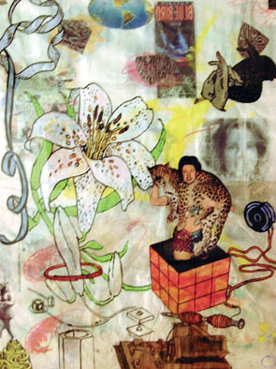Jane HAMMOND
the lily and the leopard
DIMENSIONS: 85 x 75 cm.
TECHNICAL: mixed on paper

The real subject of these drawings is not lilies or leopards but rather the experience of consciousness. That is, what it feels like to be human inside the thinking and sensing human mind, an experience that ricochets back and forth between discovering likenesses, rhymes, consonances, parallels, and similarities and leaping far afield.
Even when the mind leaps from something to something else seemingly unrelated, I suspect there is some consonance, some connection to explain why that leap, why not another one. Often times, for exmaple, the brain is triggered by sounds or smells as well as thoughts or ideas.
Smells, in particular, seem to have a deep connection to memory and the processes of association. Lilies are among the smelliest of flowers and so the deep-throated lily here is a kind of metaphor for the drinking in of smell and its relation to the linkages of consciousness. Contemporary research on the brain seems to be proving that the term “free-association”, which the surrealists used, may be a little dated — that things are, in fact triggered.
There is a profusion of images and information, yes, but no more than is in the world out your window, nor more than is in the world inside your mind. And they have connections of a sort.
For example, the leopard’s spots are like the lily’s spots, and the two live by smell.
The stamens and sepals pop out of the lily somewhat like the lady and the leopard pop out of the cube:
Somewhat like the way the bear balances on the pyramid.
The ribbon dangles languidly on the left like the wire, connecting the bell to the nail, lies languidly on the right.
The blue ribbon connects to the lily which connects to the leopard which connects to the lady, then to the cube, then the wire, nail, battery and bell.
I mean physical connections like you would see in a homemade electrical battery but also see this wired linkage of coneections in the brain. It’s a kind of flow chart of images, a thinking and sensing diagram.
Softly behind on the right is the artist watching the drawing form behind.
As you look a these images and speculate about connections between them as well as feel your own associations coming to consciousness, I think you have a heightened sense of your own mechanisms of seeing and thinking and sensing.
Jane Hammond, January 21, 2003
Exhibitions
- esencias11- Smell colour. Chemistry, art and education





